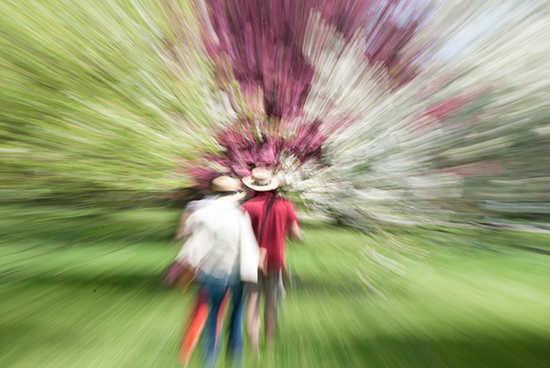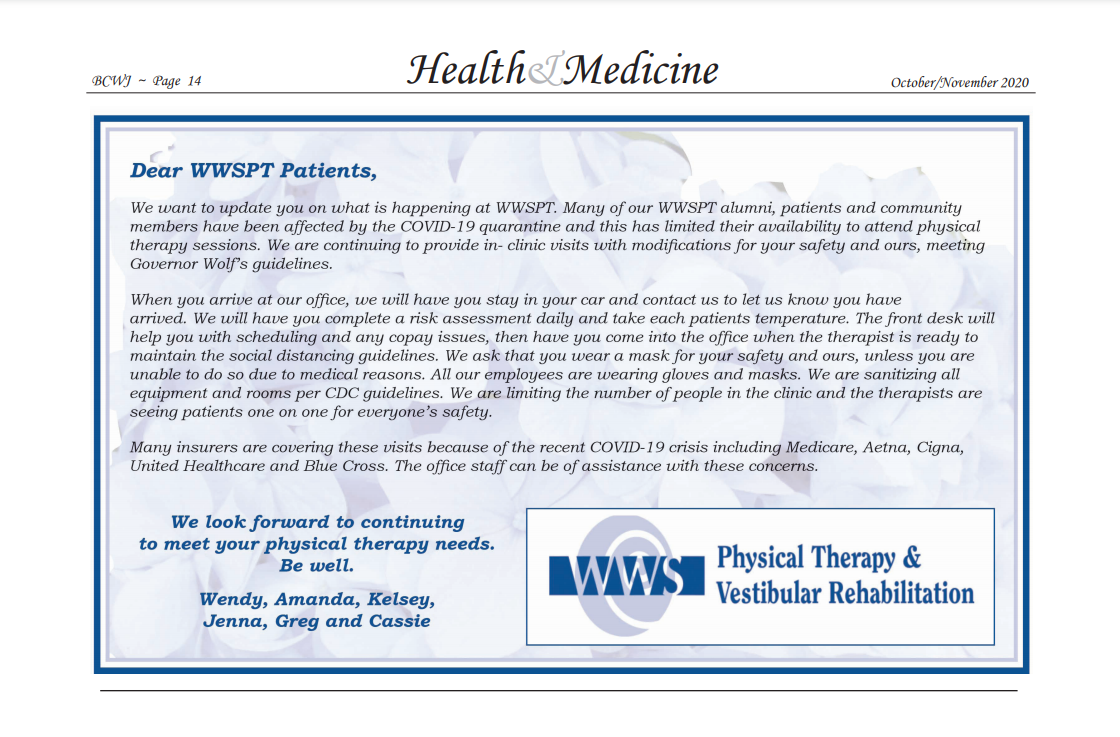
Kelsey Hanlon, PT, DPT
1456 Ferry Road
Suite 601
Doylestown, PA 18901P:215-489-3234
Healing, Function, Recovery, Health

Kelsey Hanlon, PT, DPT
People are often referred to my office for treatment with a medical diagnostic code of “dizziness and giddiness.” This is an old term used when we didn’t understand the vestibular system, but it has remained in the medical coding system. I find this diagnosis interesting because giddiness makes me think of someone laughing and happy, but most of my patients with vertigo are not either of those things! They are struggling with dizziness throughout their day and are often frustrated and fearful.
People with vertigo describe many symptoms including dizziness, spinning, nausea, vomiting, migraines, loss of balance, difficulty walking, and mental fogginess. The balance center located in our inner ear, called the vestibular system, is essential to our body’s ability to function every day. Although it is small—the size of a peanut M&M’s®—when it doesn’t work properly, it becomes a big problem. It can keep you from walking safely and thinking properly and can cause you to feel disoriented and sick.

The vestibular system’s job is to coordinate our brain and vision with our postural system. This sounds simple, but anyone who’s had a vestibular event knows that, when this system is disrupted, it makes it very difficult to see clearly or move your head quickly. It can cause disorientation so intense that it can knock you over when trying to get out of bed. Fortunately, the specialty of physical therapy known as vestibular rehabilitation can be effective in restoring balance to this tiny but powerful system. Most people referred to my office say they’ve never heard of vestibular rehabilitation, but two out of three people have had some kind of vestibular dysfunction and are aware that therapies can be helpful. According to the National Institutes of Health, about 15% of American adults, or 33 million people, had balance or dizziness problems in the past year. Often patients aren’t clearly diagnosed, so it is part of my role to look for the signs and symptoms of a vestibular problem. Due to the widespread effect that the vestibular system has on proper functioning and coordination, determining a proper diagnosis can be challenging.
The most common vestibular disorder—which accounts for a third of vertigo presentations to dizzy clinics and emergency rooms—is BPPV or Benign Paroxysmal Positional Vertigo. It is more common in adults but also presents in the younger population due to its relationship to migraine and concussion. BPPV affects the inner ear, causing spinning spells that typically last one minute or less and are provoked by a change in body or head positions like looking up to a top shelf or getting out of bed. In the inner ear, there are three structures called Semicircular Canals that sense rotational head movements. Calcium carbonate crystals sometimes get loose, and, when they find their way into these canals, they trigger a spinning sensation associated with nausea, vomiting, imbalance, and discomfort. This condition can be treated with maneuvers designed to put the crystals back into their proper location, such as the Epley maneuver. For more detailed information on BPPV, visit Http:// bit.ly/WWSPTFeb2016.

Vestibular migraine is the second most common cause of dizziness. Patients with migraine can have associated vertigo occurring with a migraine headache, afterward, or even without a headache at all. About 12% of the population suffers from migraines, with a higher prevalence in women than men. About 10% of children experience migraines, but it is most common between the ages of 25 and 55. Vestibular migraine is often preceded by visual symptoms of aura, or warning, including neurological symptoms like sensitivity to light and sound, as well as nausea and imbalance. Management of vestibular migraine includes being aware of what may trigger your migraine, drinking lots of fluids, and exercising regularly. BPPV can trigger a vestibular migraine but is also a common sequela of a migraine attack. Learn more about vestibular migraine at http://bit.ly/WWSPTOct2018.
Ménière’s disease is a well-known disorder that can cause spells of disabling vertigo and is commonly associated with hearing loss. It is thought to be a fluid imbalance problem in the inner ear, causing vertigo symptoms lasting a full day that become more disabling with each attack. The mechanism of Ménière’s is not clear, but the attack can occur frequently without a specific trigger, making it more difficult to manage.
Vestibular neuronitis, also called labyrinthitis, is an acute disorder of the inner ear caused by a virus attacking the inner ear and reducing input to your brain, which causes severe and sudden onset of dizziness and imbalance. Some patients also have associated hearing loss. Often these patients cannot get out of bed for 1 to 2 days and have symptoms of nausea, vomiting, and imbalance. In this disorder, there is damage to the vestibular nerve, so recovery can take between 3 and 12 weeks depending on the severity. The research shows that starting vestibular rehabilitation as early as possible facilitates a faster recovery.
The impact of vestibular disorders on a person’s lifestyle is considerable. They cause a significant interruption of daily activities and an increased need for medical leave from work. Most vestibular patients see 3 to 4 physicians before being properly diagnosed, affecting patients fiscally as well. Vestibular disorders are shown to impact mood, causing increased depression and anxiety. They affect cognitive status because patients are working harder to function which leads to difficulties in spatial memory and attention or “brain fog.”
The team of professionals at WWSPT is committed to the proper evaluation and diagnosis of patients with vestibular dysfunction. This helps us utilize the appropriate strategies and treatment to return you to a more active, healthy lifestyle. If you’re dizzy, please give us a call today so we can help you on the road to recovery.
Wendy Webb Schoenewald, PT, OCS
WWS Physical Therapy & Vestibular Rehabilitation
1456 Ferry Road, Suite 601
Doylestown, Pennsylvania
215.489.3234

Dizziness can happen at any age, but if it results in falling it can be a serious health concern, particularly in older adults.
Studies show that you can take action to reduce dizziness and your risk of falling. Begin by talking with your health care providers to explore medical issues that may be contributing to your symptoms, and exercise to improve your balance and strength.
Normal balance is dependent on many factors, including multiple systems of the body, as well as external and environmental factors.
The body has three primary sensory systems that work together to create postural stability. With normal brain function, the vestibular system of the inner ear coordinates with the visual system and proprioceptors that sense the position and movement of your body in space. These three systems work together while we perform simple tasks, such as standing and walking, or more complex and dynamic activities, such as yoga or hitting a golf ball accurately.

The inner ear is a complex structure of fluid-filled tubes and chambers. Specialized nerve endings inside these structures sense the position and movement of the head and detect the direction of gravity. Signals sent from the nerves of the vestibular system are critically important to the brain’s ability to control balance in standing and walking. They also control movements of the eyes that make it possible to see clearly while moving.
Anatomical studies have shown that the number of nerve cells in the vestibular system decreases after about age 55. Blood flow to the inner ear also decreases with age. When the vestibular system is damaged, an individual may experience dizziness and balance problems. However, the gradual, age-related loss of vestibular nerve endings can result in balance problems without any associated dizziness. This type of slow loss of vestibular function may be first noticed as difficulty walking or standing, especially in the dark while on soft or uneven surfaces (such as thick carpet or a forest path).
A decline in inner ear function may be caused by a number of conditions, including normal aging, benign paroxysmal positional vertigo (BPPV), infection, Meniere’s disease, or diminished blood flow to specialized nerve cells. Additionally, certain medications such as some antibiotics for severe infections and chemotherapy may damage the inner ear, resulting in temporary or permanent hearing loss, impaired balance, and trouble seeing clearly while in motion. Feelings of dizziness, vertigo, imbalance, and disequilibrium may indicate that the inner ear is not functioning correctly.
Benign Paroxysmal Positional Vertigo (BPPV) is the most common vestibular disorder in older adults and causes a sense of true spinning vertigo triggered by a change of position of the head or body. With this condition the spinning can be triggered by things like tipping your head up or down, quickly rotating your head, bending over, rolling over in bed, or getting in and out of bed. BPPV is a mechanical disorder that occurs when debris, called otoconia, loosen and tumble into the semicircular canals of the inner ear. This event causes false signals to the brain triggering a brief sense of vertigo. The spinning lasts less than a minute and can provoke nausea, vomiting, and imbalance. BPPV can be effectively treated by a Vestibular Physical Therapist with specialized training by using proven techniques, such as the Epley maneuver or canal repositioning techniques, which help return the otoconia to their correct position in the inner ear.
Labyrinthitis is an infection or inflammation of the inner ear that causes severe vertigo lasting 1-2 days, hearing loss, and severe imbalance that can affect walking. Neuronitis is a similar disorder causing vertigo, but it does not affect hearing. Both can be triggered by an upper respiratory infection, virus or flu, or can occur with no obvious cause.
Meniere’s disease causes similar symptoms, including periodic episodes of vertigo, dizziness, and hearing loss. It is thought to be a result of an excess amount of fluid, called endolymph, collecting in the inner ear.

Normal orientation also relies on healthy brain function to process, adapt, and interpret changing sensory information from the vestibular system, vision, and body input. The brain must process this information to select appropriate balancing strategies and learn new strategies necessary for changing environments. There are many disorders, such as stroke, Alzheimer’s, Parkinson’s Disease, concussion, and dementia, that interfere with brain function resulting in slower and inaccurate balance reactions. Cognitive deficits are often associated with balance problems, demonstrating the complex nature of performing dynamic balance tasks.
As you can see, balance is very complex and there are a variety of conditions that can put a person at risk of falling. See VeDA’s article Balance and Falls in Older Adults for more information.
Some people may believe feeling off-balance or having dizziness is an unavoidable consequence of aging. Here’s the good news: with proper diagnosis, many of the causes that result in imbalance, dizziness, or falls can be treated or diminished with lifestyle changes.
Start by having a thorough assessment by your primary physician at least once a year. Tell them if you are experiencing dizziness, lightheadedness, vertigo, imbalance, or have suffered a fall. There may be multiple health issues and medication interactions contributing to symptoms of dizziness and imbalance. Making an accurate diagnosis to determine the source of the symptoms may be a complicated task for your physician, and they may refer you to a specialist.
The physician should include checking for specific muscle weakness in the legs and feet or a decline in sensation, which can indicate a need for strengthening or specific footwear.
If you are experiencing dizziness with specific head movements or sitting up in bed you should be screened for BPPV. If your physician concludes that your vestibular, visual, or sensory systems are creating a risk of falling, s/he will refer you to a certified vestibular therapist who specializes in Vestibular Rehabilitation Therapy (VRT). Studies have shown that VRT can help improve balance, decrease dizziness, and decrease fall risk. A vestibular therapist is a physical therapist with specific training in the assessment of balance deficits and inner ear disorders. Exercises provided by a vestibular therapist will be based on the functional impairments that are measured in the therapist’s evaluation of the vestibular and balance systems. The exercises are designed to reduce dizziness associated with movement and improve visual clarity, balance reactions, joint mobility, and strength to decrease fall risk. (See VeDA’s article about Vestibular Rehabilitation.)

It’s essential that you see your eye doctor and make sure your glasses are the correct prescription. If you have bifocal or progressive lenses, you may want to get a pair of glasses with only your distance prescription for outdoor activities, such as walking. Sometimes progressive lenses can make things seem closer or farther away than they really are, which is especially risky when walking down steps or slopes.
It is also important to be screened for diabetes, cataracts, macular degeneration, or neuropathy.
You can also make lifestyle choices that have been shown to improve balance and facilitate good health as we age.
First, it is important to have adequate nutrition, which includes a balanced diet of fruits, vegetables, protein, and low sugar foods. You should also include supplements of Vitamin D 880 IU with calcium to strengthen the bone and reduce the risk of fractures (CDC, Shahar 2009).
Second, it has been shown that staying active and exercising can reduce fall risk in the elderly (Shubert 2011). In community-dwelling adults, a progressive exercise program with a moderate to a high level of balance exercises and cardiovascular conditioning has been shown to be an effective way to reduce falls. Exercise programs may include standing squats, single-leg standing, toe, and heel raises, tandem stance or walking, hip and knee strengthening, walking tasks, and high-level balance tasks such as reaching, turning, and stair-stepping. Tai chi is a form of exercise involving low impact dynamic movements of the arms and legs with reaching and turning, and movement of the torso in repetitive patterns. It not only benefits the body but also is cognitively challenging.
Walking is a beneficial form of exercise, especially when the additional emphasis is placed on increasing stride and speed of steps, which studies have shown to reduce falls in older adults.
Another easy step in reducing falls is to make changes to your home creating a safer environment.
Authors: By Wendy Webb Schoenewald PT, OCS and Viviann C. Bailey MSPT
Since the #COVID19 #Pandemic began, life has certainly changed. One major adjustment for our patients is the daily use of #masks when leaving their homes. Masks are necessary to keep each other healthy and mitigate risk during COVID-19, but individuals with pre-existing balance issues need to be aware of how they may further impact their #stability. When individuals struggle with #balance, especially due to #VestibularDisorders, they rely heavily on their vision to help them navigate their environment. Having a mask on can impede peripheral vision and our ability to quickly scan the area around our feet. If you or a loved one has a history of falls, make sure they are taking the appropriate measures to increase their safety including using an assistive device, avoiding trip hazards, and consider scheduling them for a #Balance tune-up with one of our vestibular specialists at #WWSPT!

Another issue we have discovered is that many of our senior citizens with varying degrees of hearing loss watch the mouths of those they speak with. You may find yourself or a family member asking “What?” a lot more often. If you have hearing aids, make sure you are wearing them especially when leaving the home since you can no longer read lips. Having diminished hearing does decrease our balance and can predispose one to falls. If you have a family member that has hearing loss, make sure you are speaking loudly and make eye contact with them when you speak so they know you are talking. Also, make sure that the other senses can be optimally used, i.e. no walking in the dark or dim lighting, use your assistive device, tidy up around your environment to avoid tripping, and have that balance issue assessed at our practice.
Be proactive about your #health and #safety and we welcome you at our practice for a thorough #BalanceandGaitAssessment! You’d much rather treat a balance dysfunction before it turns into a fall or a more serious consequence of falling. Contact us to schedule an appointment.
Dr. Jenna Mclane
WWS Physical Therapy & Vestibular Rehabilitation
We strive to provide an environment of recovery and healing for our clients, to allow them to advance their health and return to function, recreation or sports. It is our belief that Physical Therapy is the initial link in the healthcare system for Musculoskeletal and Balance related issues and we are the true experts on exercise. We look forward to a long term relationship with our patients and their families over their life span and hope to become their practitioner of choice for acute musculoskeletal issues, neuromuscular issues as well as reoccurring events limiting their Wellness. We want to be a part of our patients Healthy living and Healthy aging.